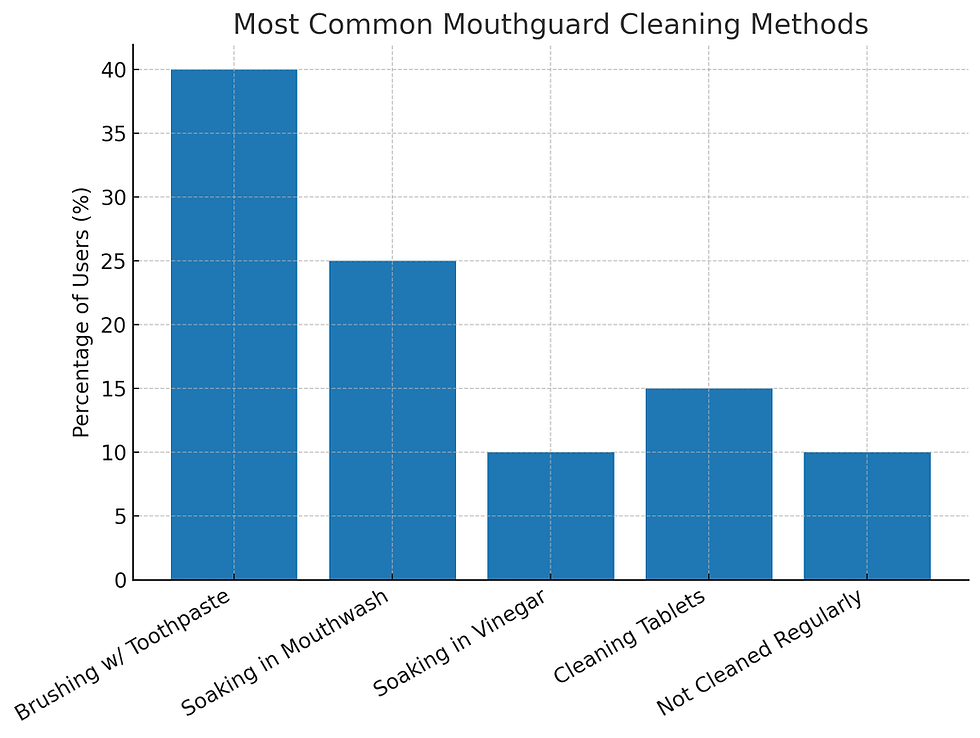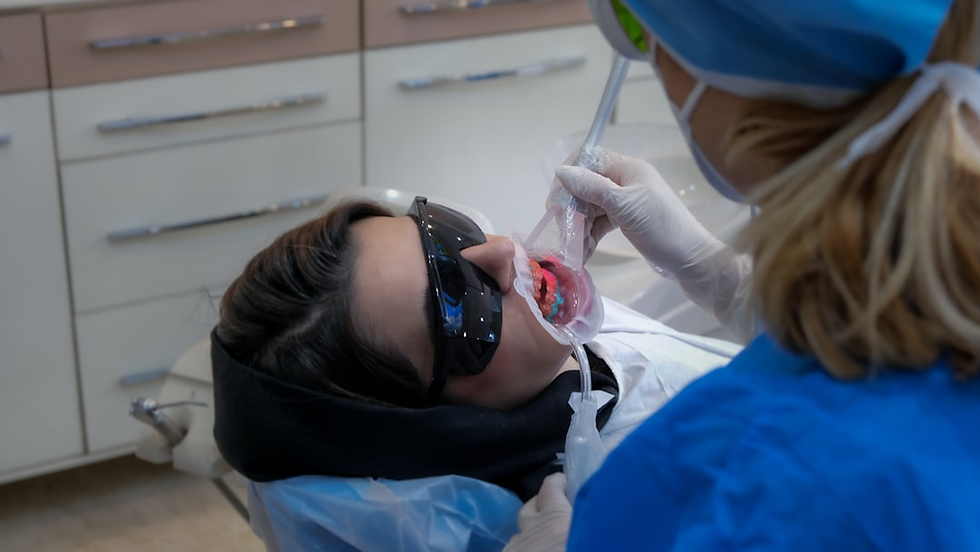How to Clean Mouth Guard
- plurefy com
- Aug 18
- 6 min read
Updated: Aug 25

A mouth guard can become a haven for bacteria, mold, and yeast if not cleaned properly. These microorganisms may cause bad breath, infections, or even impact your dental health. Additionally, a clean mouth guard ensures it works effectively, offering the protection and comfort you need.
Health Implications of a Dirty Mouth Guard
A dirty mouth guard can contain harmful bacteria that might cause oral infections or worsen existing dental conditions. The buildup of plaque and bacteria can lead to gum diseases, cavities, and other dental problems. Furthermore, using an unclean mouth guard can transfer bacteria to your throat and respiratory system, possibly resulting in respiratory infections.
Impact on Mouth Guard Longevity
Regular cleaning not only safeguards your health but also extends the lifespan of your mouth guard. Bacteria and mold can deteriorate the material over time, necessitating more frequent replacements. By keeping your mouth guard clean, you ensure it stays in good condition, preserving its effectiveness and saving you money in the long term.
Enhancing Comfort and Fit
A clean mouth guard fits better and feels more comfortable when used. Residue buildup can change the shape and fit of the guard, leading to discomfort or irritation. Regular cleaning keeps your mouth guard snug and secure, ensuring optimal protection during use.

Types of Mouth Guards
Before exploring cleaning techniques, it's crucial to understand the various types of mouth guards, as they might need slightly different care.
Sports Mouth Guards
Sports mouth guards, crafted to shield the teeth during physical activities, are generally more durable and can be cleaned with a bit more vigor.
Materials and Construction
Sports mouth guards are typically crafted from strong materials such as EVA (ethylene vinyl acetate) to endure impact. This durability permits more thorough cleaning methods without affecting the guard's integrity.
Cleaning Challenges
Although sports mouth guards are durable, they can easily accumulate dirt and debris from outdoor environments. Careful cleaning is necessary to eliminate any grass, mud, or other particles that may adhere to the surface.
Maintenance Tips
Frequent checks for cracks or noticeable wear are essential for sports mouth guards. If they exhibit any damage, replace them to maintain consistent protection during activities.
Dental Mouth Guards
These guards are utilized to prevent teeth grinding (bruxism) or as a component of orthodontic treatment. They are typically crafted from softer materials and need careful cleaning.
Material Sensitivity
Mouth guards for dental use are typically made from softer, more flexible materials to ensure comfort during extended wear. This delicate nature requires milder cleaning techniques to prevent damage.
Cleaning Approach
It is essential to use mild, non-abrasive cleaners for dental mouth guards. Care must be taken to avoid hot water and harsh chemicals, as they can warp the material.
Protection and Care
Consistent cleaning and appropriate storage in a ventilated case can preserve the integrity of dental mouth guards, ensuring they offer effective protection against grinding.
Night Guards
Like dental mouth guards, night guards are used while sleeping and require regular cleaning to avoid bacteria accumulation.
Overnight Exposure
Night guards are in contact with saliva and bacteria for long durations, which heightens the likelihood of bacterial growth. Proper cleaning is crucial to reduce this risk.
Cleaning Frequency
Besides daily cleaning, night guards should undergo a weekly deep clean to eliminate accumulated bacteria and maintain hygiene.
Storage Solutions
Storing night guards in a dry, well-ventilated case helps prevent moisture accumulation, thereby reducing the risk of mold and bacterial growth.
How to Clean a Mouth Guard: Step-by-Step

Daily Cleaning Routine
Rinse Immediately After Use: Once you remove your mouth guard, rinse it under cool, running water to eliminate saliva and debris. It's essential to rinse your mouth guard right after use to stop saliva from drying on the surface. Dried saliva can cause mineral deposits that are more difficult to clean later.
Brush with Toothpaste: Use a soft-bristled toothbrush and non-abrasive toothpaste to gently clean the entire surface of the mouth guard. Avoid using hot water, as it can deform the material.
Brushing should be gentle yet thorough, ensuring all surfaces are covered, including the crevices where bacteria may hide. Avoid using toothpaste with whitening agents or abrasives that could scratch the guard.
Rinse Thoroughly: After brushing, rinse the mouth guard again to remove any remaining toothpaste residue.
Make sure all toothpaste is rinsed off to prevent potential irritation from residue. A thorough rinse ensures the guard is free from cleaning agents that might affect its material.
Dry Completely: Allow your mouth guard to air dry completely before storing it. Placing a damp mouth guard in its case can encourage bacteria and mold growth.
Drying is a critical step in preventing bacterial growth. Place the mouth guard on a clean, dry surface and let it air dry completely. Avoid using towels, which can introduce fibers and bacteria. Store Properly: Store the mouth guard in a ventilated case to keep it dry and protected. A well-ventilated case prevents moisture buildup and protects the mouth guard from environmental contaminants. Ensure the case is clean and dry before placing the guard inside.
Deep Cleaning Methods - How to Clean Mouth Guard
In addition to daily cleaning, perform a deep clean once a week to ensure your mouth guard remains hygienic.
Vinegar and Hydrogen Peroxide Method
Soak in Vinegar: Submerge the mouth guard in white vinegar for 30 minutes.
White vinegar is a natural disinfectant that effectively breaks down bacteria and removes odors. Ensure the entire mouth guard is submerged for maximum effectiveness.
Rinse: Rinse the guard thoroughly with water to remove the vinegar.
Rinsing is essential to remove the acidic residue of vinegar, which can affect taste and comfort if left on the guard.
Soak in Hydrogen Peroxide: Place the mouth guard in hydrogen peroxide for another 30 minutes to kill remaining bacteria.
Hydrogen peroxide is a powerful antiseptic that further sanitizes the mouth guard. Use food-grade hydrogen peroxide for safety.
Final Rinse and Dry: Rinse thoroughly with water and let it dry completely.
A final rinse ensures all cleaning agents are removed. Allow the mouth guard to dry thoroughly before storing it to prevent moisture-related issues.

Mouthwash Soak
Prepare a Solution: Combine equal amounts of mouthwash and water in a container.
Select an alcohol-free mouthwash to avoid damaging the mouth guard material. Dilution is crucial to ensure the solution isn't too strong.
Soak: Allow the mouth guard to soak for 30 minutes. The mouthwash will help eliminate bacteria and leave a fresh scent. Soaking in mouthwash not only disinfects but also adds a pleasant flavor to the mouth guard, enhancing the user experience.
Rinse and Dry: Rinse with water and dry thoroughly before storing. Thorough rinsing removes any remaining mouthwash taste, ensuring comfort during use. Complete drying prevents mold growth.
Using Denture Cleaner
Denture cleaner tablets can also be used to clean mouth guards.
Tablet Dissolution: Dissolve a denture cleaning tablet in a glass of water. Denture cleaners are formulated to be gentle yet effective, making them perfect for maintaining mouth guards. Follow the package instructions for optimal results.
Soak Mouth Guard: Immerse the mouth guard in the solution for the duration recommended on the package, typically 5-10 minutes. The effervescent action of the cleaner helps dislodge any persistent debris or bacteria, ensuring a thorough cleaning.
Rinse and Dry: Rinse thoroughly with water and allow it to dry completely.
Make sure all cleaning residues are rinsed off, leaving the mouth guard fresh and ready for use. Complete drying prevents any potential bacterial growth.
Additional Tips
Avoid Using Hot Water: Hot water can distort the material of your mouth guard, impacting its fit and effectiveness. Always use cool or lukewarm water for cleaning to preserve the structural integrity of your mouth guard. Warped guards may not offer adequate protection.
Do Not Use Harsh Chemicals: Bleach or alcohol-based cleaners can deteriorate the mouth guard material over time.
Harsh chemicals can create micro-cracks in the material, leading to faster degradation and potential health risks.
Regular Replacement: Depending on wear and tear, consider replacing your mouth guard every six months to a year for optimal protection and hygiene.
Regularly assessing your mouth guard's condition ensures it continues to provide effective protection. Replace it if there are signs of significant wear.
Consult Your Dentist: If you notice any cracks or if the mouth guard becomes uncomfortable, consult your dentist for advice or replacement.
A dental professional can provide guidance on proper maintenance and timely replacement of your mouth guard, ensuring ongoing oral health and protection.

Troubleshooting Common Issues

by Erfan Amiri (https://unsplash.com/@erfanamiri)
Foul Odor
If your mouth guard begins to give off a bad smell, it could be because it's not being cleaned properly. Make sure to follow the deep cleaning routine regularly.
Causes of Odor
Odor can arise from bacterial accumulation, insufficient drying, or inadequate cleaning. Consistent deep cleaning and proper drying can help alleviate these problems.
Solutions for Freshness
Think about regularly soaking in mouthwash to keep a fresh scent. Make sure it dries completely and store it in a clean, ventilated case.
Preventive Measures
Establish a regular cleaning schedule, incorporating both daily and weekly deep cleaning, to avoid odor problems.
Discoloration
Over time, discoloration can develop. If deep cleaning doesn't restore its look, it may be time to consider a replacement.
Factors Leading to Discoloration
Exposure to certain foods, beverages, or ineffective cleaning methods can cause discoloration. Additionally, materials may naturally yellow with age.
Restorative Actions
Consider using denture cleaners or specialized mouth guard cleaning solutions to restore color. If these efforts fail, replacement might be necessary.
Replacement Considerations
If discoloration remains despite cleaning attempts, consult your dentist about getting a new mouth guard to maintain hygiene and aesthetics.
Rough Edges
Wear can lead to rough edges, which may irritate gums or cheeks. Consult your dentist if you notice any texture changes in your mouth guard.
Identification of Rough Edges
Regularly check your mouth guard for roughness or damage, especially in areas that contact the gums.
Addressing Discomfort
If rough edges cause discomfort, stop using it and seek advice from a dental professional. Temporary filing might be possible, but professional guidance is advised.
Professional Evaluation
Your dentist can evaluate the degree of wear and suggest repair or replacement to ensure comfort and protection.
Conclusion
Regularly cleaning your mouth guard is a straightforward yet effective method to keep it hygienic and functional. By incorporating daily rinsing and brushing, along with weekly deep cleaning, you can prolong the life of your mouth guard and protect your oral health. Remember, a clean mouth guard not only safeguards your teeth but also contributes to your overall well-being. Consistent care and maintenance are essential to ensuring your mouth guard continues to serve you well.










Comments